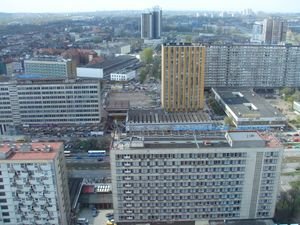Advertisement
Published: April 18th 2008

 Katowice, Poland
Katowice, Poland
City scene in Katowice, Poland.The first thing we do when we land in a new place is to get a street map and try to get ourselves oriented on it. This involves walking around quite a bit to see what's nearby in every direction from our hotel. So far, in Katowice we have seen lots of apartment buildings, one university, a few churches and some shops and restaurants. This place is not geared toward the tourist and so it doesn't have the pizzazz that can be found elsewhere. It's kinda of refreshing actually. Still, Katowice gives us an idea of what urban Poland can normally look like.
A few interesting things have struck our eyes. One is that the fashions here are a bit more of a mish-mash than what we saw in Paris. At least some of the folks here add little splashes of color to their Basic Euro Black outfits. Indian jamavar scarbes are very popular here. And I think I have seen more pairs of bright yellow shoes in the space of 4 days here than I have anywhere else. One odd thing is that quite a few of the ladies have dyed their hair a reddish-magenta shade. Later I read

 Wieliczka Salt Mine
Wieliczka Salt Mine
Exterior of the Salt Mine southeast of Krakow.that for a long time, that was the only color of hair dye available.
One of the guys from work, Martin, who lives in Krakow but commutes to Katowice for work, kindly offered to take us to the Wieliczka Salt Mine southeast of Krakow. So after work, we piled into his little Fiat and drove the roughly 40 miles to Krakow. We snagged tickets for the last guided tour of the day, at 7 pm. The mine is historic, having been a working mine for about 900 years, only ceasing operations in 1996. Our guide spoke only Polish but luckily, there was a fella in our group who had an English friend for whom he translated. So we listened in. We descended down more wooden steps than I could count, down the mine shaft into the uppermost chamber. We were taken through various galleries and chambers and down a several more levels.
The history of the mine and extraction procedures was explained. Most of the excavation work was done by hand but beginning in the 1600s, horses were used in the mine to move the excavated salt. Imagine horses (and men too!) practically living underground who never saw

 St. Kinga Cathedral
St. Kinga Cathedral
A massive cathedral carved out of salt.the light of day! Featured in the numerous chambers were many exquisite sculptures carved from the salt. In fact, more than one chapel was artfully and finely carved underground. The largest and most impressive is the St. Kinga Chapel which encompassed a massive room complete with an altar and The Last Supper and other religious depictions lining the walls. Contrary to what you might think, the rock salt is a gray to grayish-green color and not white.
After the tour, Martin came back to pick us up. He brought his girlfriend, Iwona, along to meet us. She got to practice here English while we rode to the main train station at Krakow Glowny. From there we caught a train to bring us back to Katowice. After an hour and a half on the train and having not had a proper dinner, we stopped by a McDonald's on the way back to our hotel. I haven't been in one in years and was impressed with the current offerings though there wasn't much we could eat. Yet, at nearly midnight, some warm french fries sounded like our only choice although we did have some instant oatmeal and yogurt back at our

 Last Supper
Last Supper
The Last Supper carved in salt. Amazing detail for only being 6 inches deep.room.
Bedtime! More fun adventures coming soon!
Advertisement
Tot: 0.24s; Tpl: 0.01s; cc: 11; qc: 48; dbt: 0.0492s; 1; m:domysql w:travelblog (10.17.0.13); sld: 1;
; mem: 1.1mb

 Katowice, Poland
Katowice, Poland
 Wieliczka Salt Mine
Wieliczka Salt Mine
 St. Kinga Cathedral
St. Kinga Cathedral
 Last Supper
Last Supper